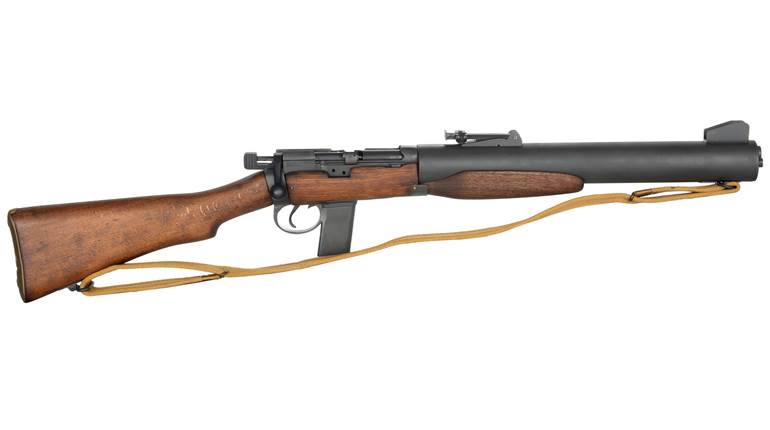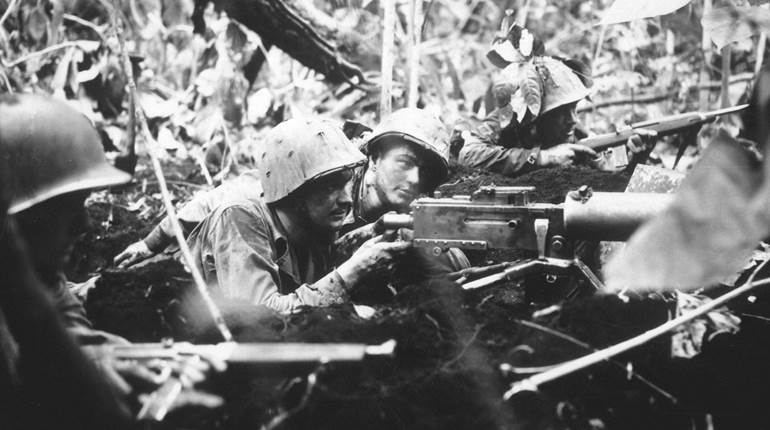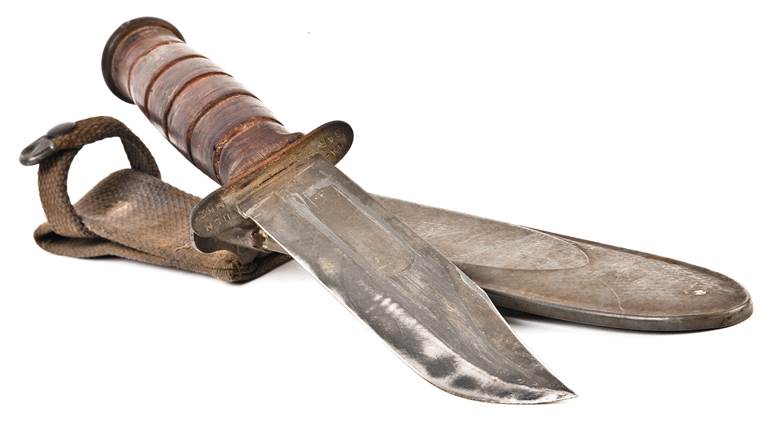
Smith Manufacturing Group has created semi-automatic versions of Germany’s World War II era FG42, both Type I and Type II, select-fire machine rifles in the full-power 7.92x57 mm Mauser cartridge. The unearthly looks of the FG42 variants evoke science-fiction movie comparisons, and both are head-turners at the range. Of the two, the earlier Type I has become my favorite for several reasons.
First and foremost is the rakish pistol grip. When I first handled the rifle, I didn’t like it, but on firing the rifle, it quickly became apparent that it felt like a typical sporting rifle between the hands, due to the angle. Balance is exceptional for so heavy a rifle.
Secondly, the fully adjustable folding iron sights, with a triangular-shaped front paired with an aperture rear, lends confidence that I could place rounds downrange exactly where I want. It’s an amazing setup, and one I think should be explored more on modern rifles. Optic ready, the folding sights are perhaps the very first use of BUIS, or backup iron sights, which have become a more-or-less a standard on modern sporting rifles today.
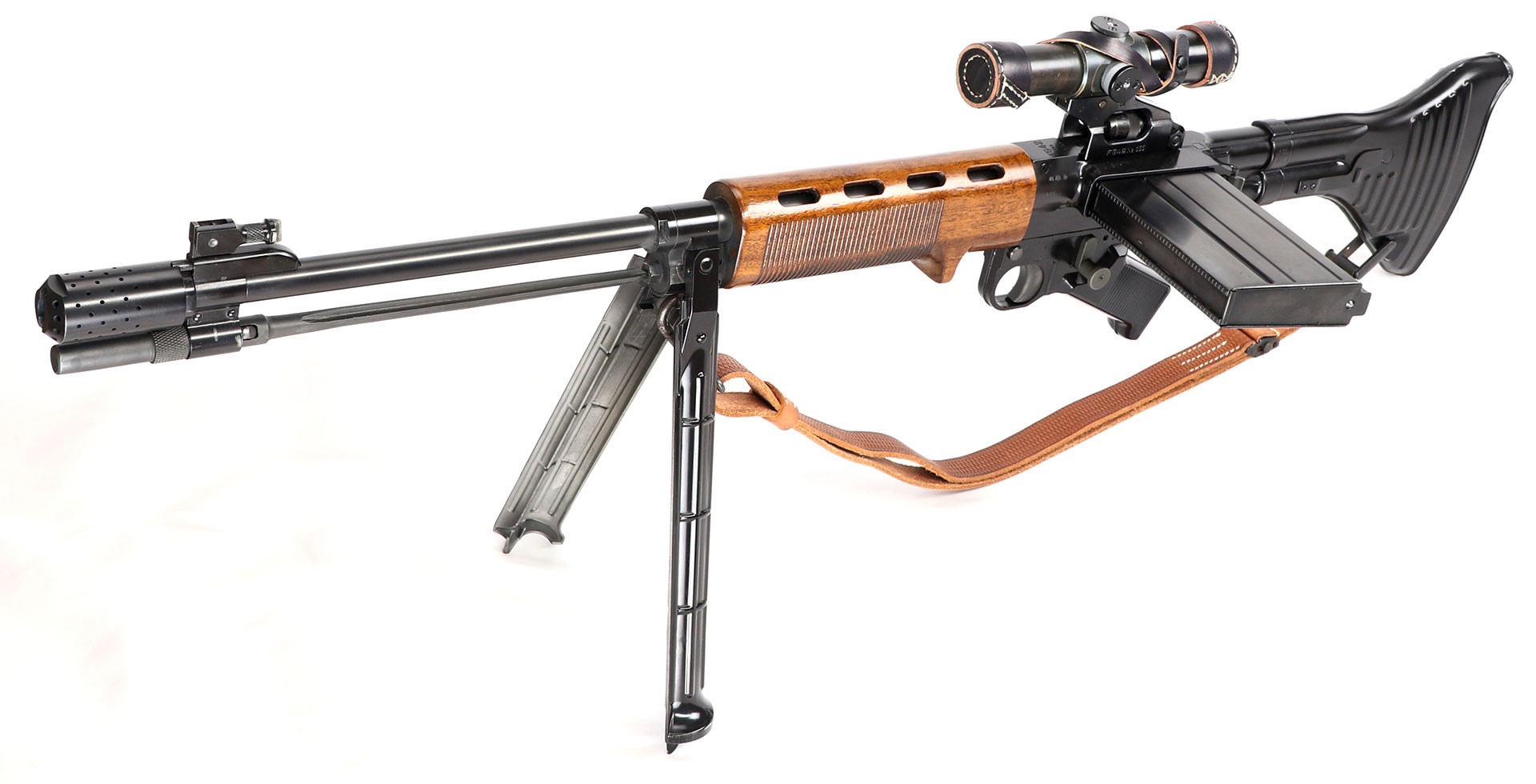 The FG42 (Type I shown here) has a vestigial bayonet, based on the French Mas 36, and a bipod. The bipod tends to fold spontaneously under recoil, and Smith Manufacturing Group has added locks to hold it in place. Still, it’s best to keep the rifle out of the dirt, since it offers no traverse and the rifle must be lifted in order to change aim. The sling is unusual, with a carabiner hook at the front and a Gew98 attachment at the rear (similar to the MG34 and MG42). Only At The Front offers the shorter Type I FG42 sling currently.
The FG42 (Type I shown here) has a vestigial bayonet, based on the French Mas 36, and a bipod. The bipod tends to fold spontaneously under recoil, and Smith Manufacturing Group has added locks to hold it in place. Still, it’s best to keep the rifle out of the dirt, since it offers no traverse and the rifle must be lifted in order to change aim. The sling is unusual, with a carabiner hook at the front and a Gew98 attachment at the rear (similar to the MG34 and MG42). Only At The Front offers the shorter Type I FG42 sling currently.
Third, the ZFG42 scope and mount are quick detachable, and hold zero even when taken off and remounted. Smith Manufacturing cosmetically modifies a new-made Russian copy of the World War II era, Soviet-made, PU 3.5X scope to replicate the German ZFG42 scope. While could be seen as a bit scandalous, the PU scope is easier to find (or was), has turrets on the same side as the ZFG42, the proper reticle and the mechanics are far better than the alternatives.
Finally, the Type I has a manual bolt hold-open mechanism, which the Type II doesn’t, that comes in very handy at the range and when changing magazines. However, the one downside is the magazines. The Smith Manufacturing FG42 uses Czech ZB26/30 magazines, which have been obsolete for half a century. All magazines are used, expensive and have weak springs that often cause problems. But, before we go to the range, let’s look at why the rifle was built.
In 1941, Germany’s Fallschirmjägers, or paratroopers, failed in their attempt to take the island of Crete, partly because they jumped in with only handguns and submachine guns, while their rifles and heavy weapons were parachuted in with large canisters. The canisters made for wonderful targets, and the British “brassed up” the German troops with rifle, Bren and Vickers machine gun fire as they tried to remove weapons from those canisters.
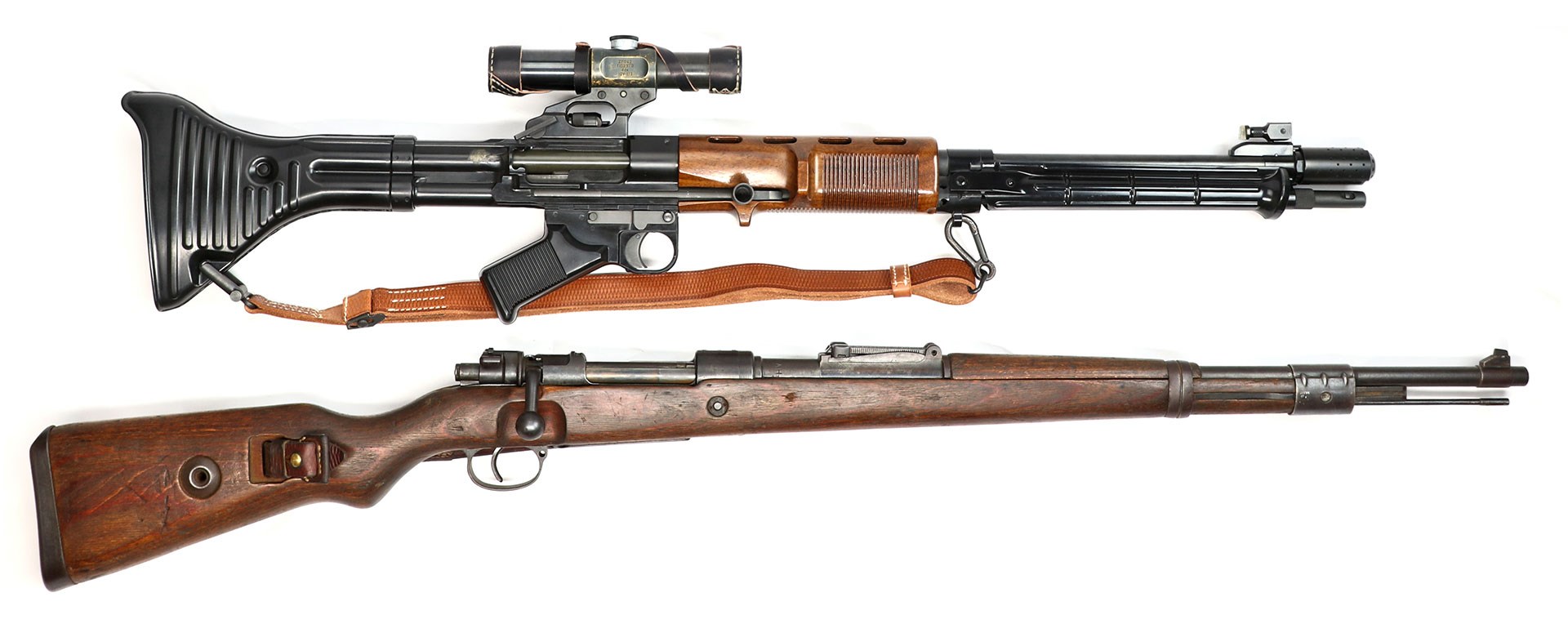
The FG42 Type I (top) is 1 meter in length (37.5"), has a 500 mm long barrel (19.65") and uses a 20-round detachable box magazine. Shorter than the standard bolt-action K98k (bottom), the FG42 was a quantum leap for the infantry rifle. Both are chambered in the 7.92x57 mm cartridge. Unusual for a German small arm, the FG42 is gas operated and has aperture sights. The German army favored notched tangent sights and recoil operation as a rule.
With this debacle, the Germans sought a compact rifle that could be utilized as a support weapon similar to standard machine guns. The FG42 was designed as a select-fire machine rifle the soldier could jump with on his person. The rakish pistol grip would allow them to defend themselves going out the airplane’s door, however fanciful that seems. However, Hitler forbade anymore jumps and the development of a new rifle, lest it interrupt K98k production (the German army was under a similar interdiction, yet was secretly developing the StG 44 in 7.92x33 mm Kurz).
Undeterred, Luftwaffe engineers laid out the parameters for the new FG42. Most importantly, the rifle was designed to use the standard service cartridge, feature a length of 1 meter, weigh no more than the K98k, have a detachable magazine, be optic-ready, have an integral bipod and bayonet, fire from an open bolt on full auto, a closed bolt on semi-automatic, have inline recoil, a muzzle brake and buttstock-housed buffer. All German small arms makers considered the arm an impossibility. Equally undeterred, Hermann Göring authorized the development of the rifle at Rheinmetall, since he was on their board of directors.
Rheinmetall’s talented gun designer Louis Stange developed a working model in just three months. This is mostly unheard of, but Stange borrowed freely from other arms. Examining a captured one, the U.S. Aberdeen Proving Grounds identified five different influences, the most important of which were the Lewis and M1941 Johnson light machine guns. The Johnson weighed only 13 lbs., had folding rear sight, a 30-round, side-feed magazine and integral bipod.
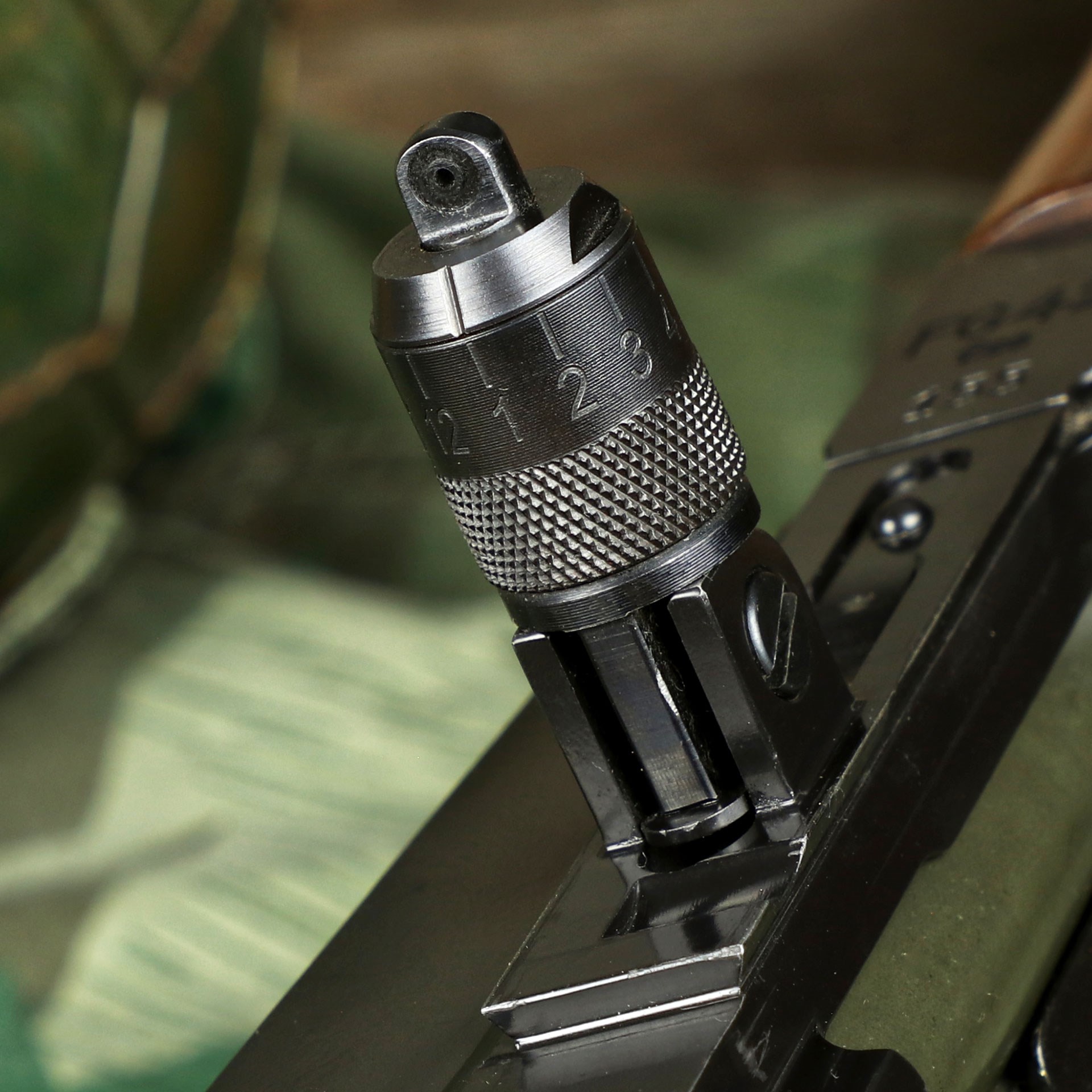 The sights are unusual, by pairing a triangle front (standard on many German small arms) with an adjustable aperture rear. Here's a closer look at the folding rear sight aperture. Pressing down on the aperture collar allows the elevation drum to turn. The aperture will pop up and lock itself in place. Smith Manufacturing offers windage adjustment to the rear, something very beneficial but lacking on originals.
The sights are unusual, by pairing a triangle front (standard on many German small arms) with an adjustable aperture rear. Here's a closer look at the folding rear sight aperture. Pressing down on the aperture collar allows the elevation drum to turn. The aperture will pop up and lock itself in place. Smith Manufacturing offers windage adjustment to the rear, something very beneficial but lacking on originals.
By Christmas 1942, the first 50 rifles were ready, and Göring demonstrated one for Hitler. Impressed, he christened it as the "Fallshirmjägergewehr 42," and opined the whole German army would use them after the war. Accuracy of the originals was as good as the K98k, with both optics or irons.
Smith Manufacturing's Type I replica features a machined receiver (just like the original), starting out as 21.4 lbs. of 4140 steel, machined down into a 1.9 lbs. part with an integral magazine well. The bolt is made from 9310 steel, known for its core hardness and high fatigue resistance. This kind of steel is commonly found in gears and crankshafts in the automotive and aircraft industries.
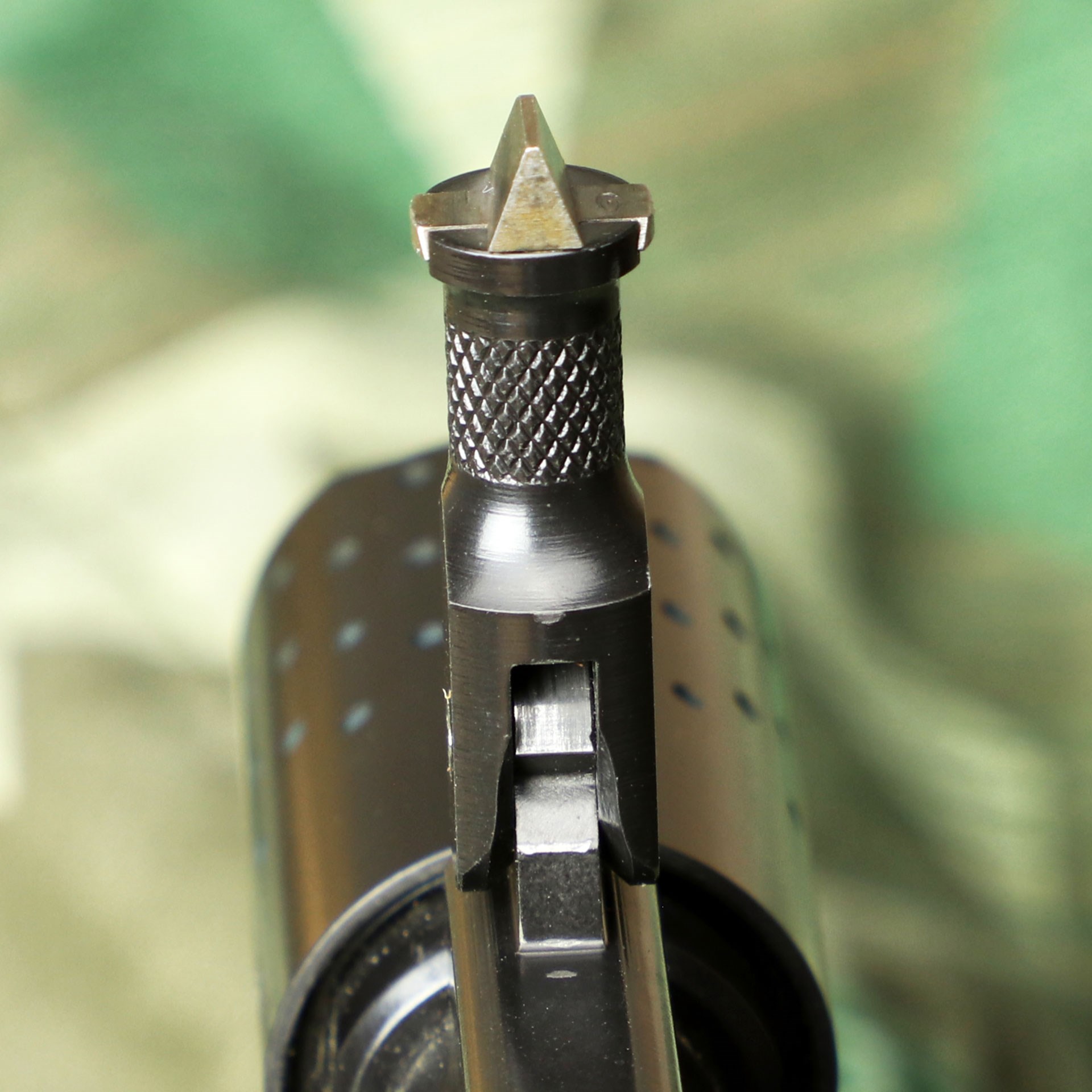 A closer look at the triangle front sight. Pulling up on the sight on the area that is checkered allows the sight to be folded backward.
A closer look at the triangle front sight. Pulling up on the sight on the area that is checkered allows the sight to be folded backward.
Bolts are then heat-treated and given a Parkerized finish. The receiver and other parts can be painted, blued or given a Cerakote finish (my choice). The shark-fin buttstock is machined and welded together. This particular model features the early small-sized trigger guard. After complaints from the field, the trigger guards were modified on the assembly line by cutting away the front and spot welding and riveting a larger strap of steel. Smith Manufacturing offers both versions for its builds.
The weight of the Smith Manufacturing Type I FG42 is heavier than the original at 10 lbs., 15 ozs. With a full magazine of 7.92 mm ammo and the optic fitted, the overall weight reaches a whopping 14+ lbs. Yet, recoil is mild. I found that I could shoot groups just as well with the iron sights as I could with the scope, but my eyes tire more quickly shooting irons. Accuracy of the Smith Manufacturing FG42 is good, but requires more effort from the shooter than any other rifle I’ve ever encountered.
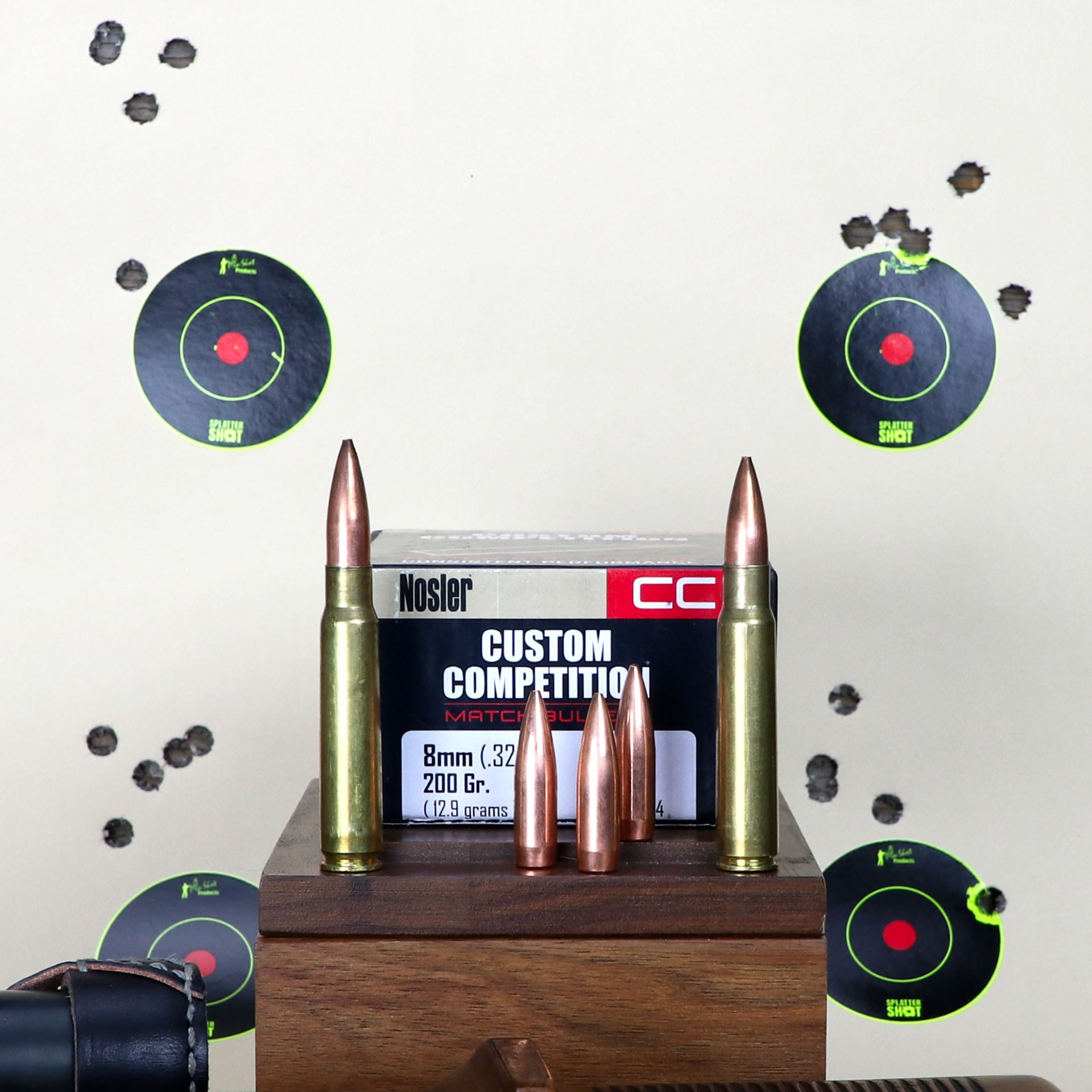
Considering all that goes on with the rifle prior to ignition, achieving 100-yard groups like this shows the rifle’s inherent potential. The group on the left has the bullet seated out to the maximum overall length that will fit into the magazine. Velocity was slightly higher, and groups shrank to 1 1/8” (bottom left). The upper group is fine, but the flyer came from a slightly relaxed hold. Holding this rifle tightly is key to accuracy. Seating the bullets a little deeper, as the Nosler manual suggested, gave slightly larger groups and about 15 f.p.s. less velocity (right two groups).
What makes the rifle such a beast is the operating system. To charge the rifle, a sharp tug on the charging handle is required to unlock and pull the bolt rearward. It will not open if you pull it the way you would a M1A or FAL charging handle. Once charged, things get interesting. The trigger pull is 10 lbs., and entails about 1/2" of travel before it breaks. But, that’s not the only impediment to accuracy, as the ignition sequence is also unique.
The bolt is at rest and locked prior to ignition. Ignition starts when the trigger is squeezed. The firing pin, which rides atop a yoke on the gas piston, flies forward with the rest of the assembly to strike the primer. This yoke holds the firing pin 1-1/4" above the piston. After charging or cycling, the piston and firing pin are stopped again by the sear, with about 5/8" of travel left, and a spring behind the bolt pushes it home to lock. The gas piston and firing pin weigh a whopping 1 lb., 2.5 ozs., and all that mass travels forward in order to ignite the cartridge. This means that one-tenth of the rifle’s overall weight is in motion prior to ignition.
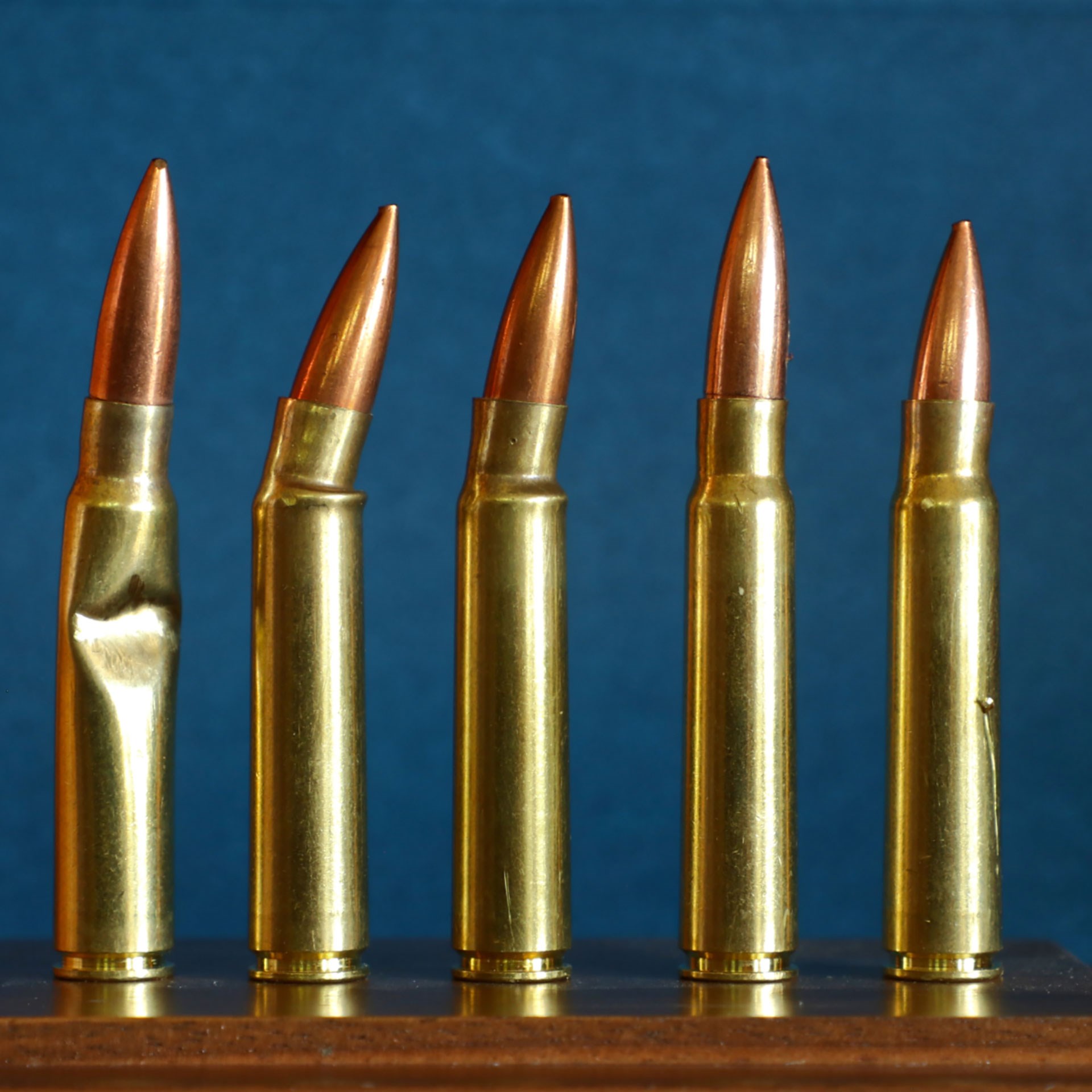 The FG42 can be a mauler on cartridges. The Prvi Partisan 7.92 mm ammunition gave some other types of heartburn as well. While it had decent accuracy, the brass was soft, and some rounds were bent going up the feed ramp. This only became apparent after a suitable quantity of such deformation occurred.
The FG42 can be a mauler on cartridges. The Prvi Partisan 7.92 mm ammunition gave some other types of heartburn as well. While it had decent accuracy, the brass was soft, and some rounds were bent going up the feed ramp. This only became apparent after a suitable quantity of such deformation occurred.
My secret to shooting good groups is holding the rifle tightly, with both hands, over a sandbag and pulling it back firmly into my shoulder pocket. I find that I could shoot about five rounds accurately doing so, but I must also relax a bit between groups. Five rounds is my limit for the muscle power necessary to make the tight hold, along with trigger management. When doing so, I can keep the group sizes under 1.5 m.o.a., but any relaxing of my grip causes groups to explode. This is a perishable skill, and it takes a few rounds to master after some time off the trigger.
Another secret to accuracy is handloading for the gas system. Factory Prvi Partisan 7.92 mm ball and match ammo shot well but cycled the gun too hard. The spent casings were launched a good 25 yards away and dented the snot out of the case necks. These loadings only produced a muzzle velocity of 2,100 f.p.s. Turning the gas valve down, the rifle didn’t cycle with the loadings at all. The brass of these cartridges was soft, too, and some cases were bent trying to go up the feed ramp (this operating system does wicked things to ammo and brass).
Switching to a handloads, featuring Nosler 200-grain BTHP match bullets in Nosler brass, solved these woes. Velocity at the starting charge, 43.5 grains of Varget, averaged a decent 2,326 f.p.s., and the cases weren’t dented as badly. Accuracy was also great with this loading. The best group was 1-1/8" at 100 yards, with an average of 1-1/2".
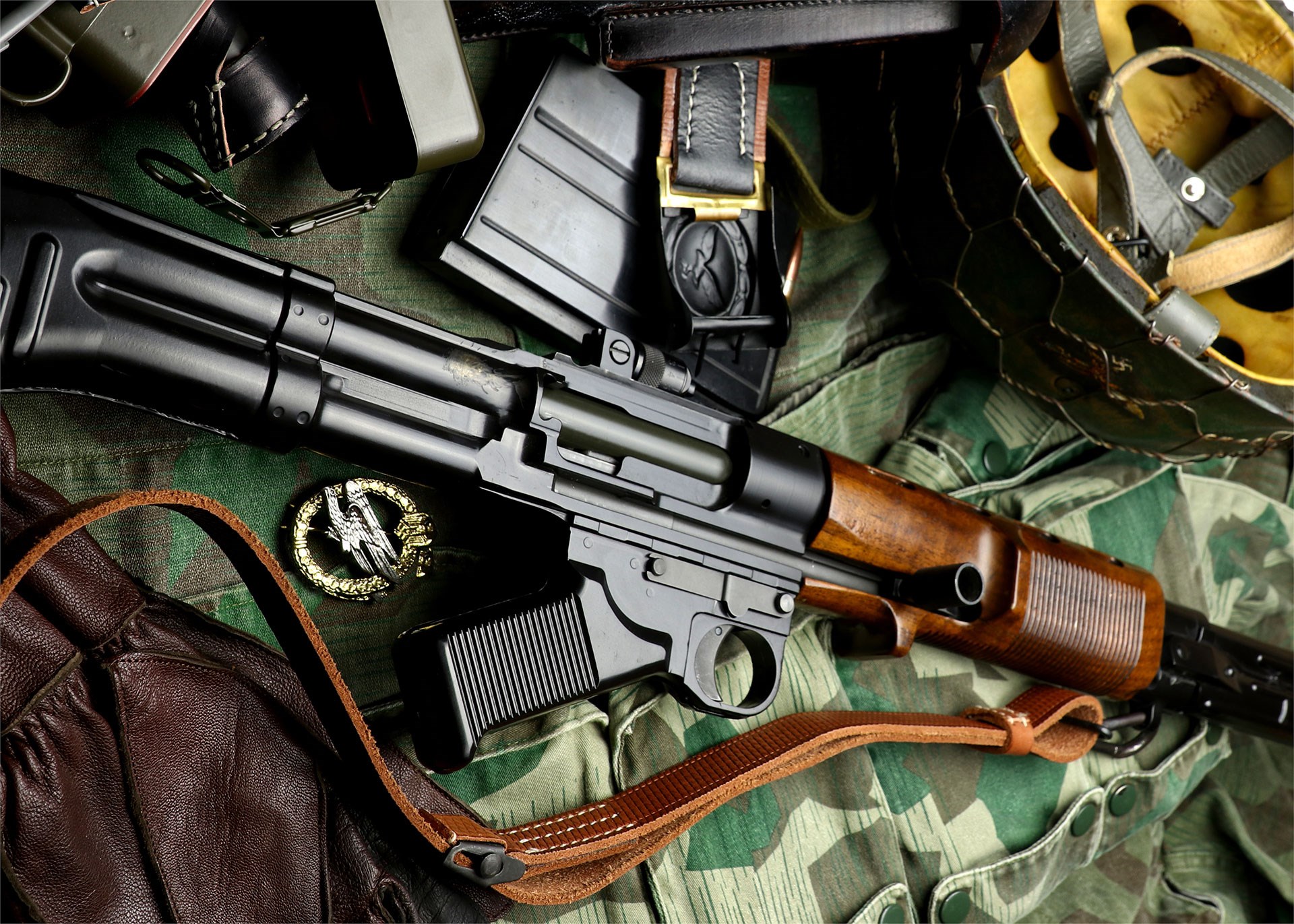 With its unearthly looks, the Type I FG42 is something of a precursor to today’s modern sporting rifles, but in a full-power cartridge. The one rifle that solved the full-power, machine-rifle conundrum equally as well was Eugene Stoner’s original AR-10. Both FG42 designer Louis Stange and Stoner were inspired by Melvin Johnson’s M1941 light machine gun.
With its unearthly looks, the Type I FG42 is something of a precursor to today’s modern sporting rifles, but in a full-power cartridge. The one rifle that solved the full-power, machine-rifle conundrum equally as well was Eugene Stoner’s original AR-10. Both FG42 designer Louis Stange and Stoner were inspired by Melvin Johnson’s M1941 light machine gun.
Disassembly can be accomplished without tools, but there are a couple of tricks to it. First, is to press down on the buttstock to relieve pressure on the stock’s button (easy by pressing down on the butt with the muzzle resting on a piece of wood or carpet). This was a weak point with the original versions as well. Second is the charging handle, which sometimes gets trapped by its retaining button inside the gas piston. Gently tapping the back of the receiver with a mallet frees the charging handle quickly.
These rifles prefers to run wet, and I lube the high-load parts of the bolt with G96 RFG grease, and use G96 Synthetic CLP everywhere else. The RFG grease stays on the moving parts, even over long shooting sessions of 200 rounds or more. Once mastered, the Smith Manufacturing FG42 it is truly an amazing rifle. The price is high at $5,750. This is actually a deal, considering the few transferable, select-fire originals sell at a much higher range of $275,000 to $300,000.
Aberdeen Proving Grounds determined the rifle would be too expensive to build stateside but counseled Springfield Armory to test one chambered in .30-'06 Sprg. before replacing the M1 Garand. The FG42 adroitly solved the problems of recoil, accuracy and cook-offs caused by a closed-bolt. This select-fire machine rifle also included optic readiness, something the M14 and FAL failed to accommodate. Smith Manufacturing Group's FG42s are an interesting reincarnation of one of the most unusual small arms developed during World War II. Time ran out before it was perfected, but that just adds to its charm and intrigue.













